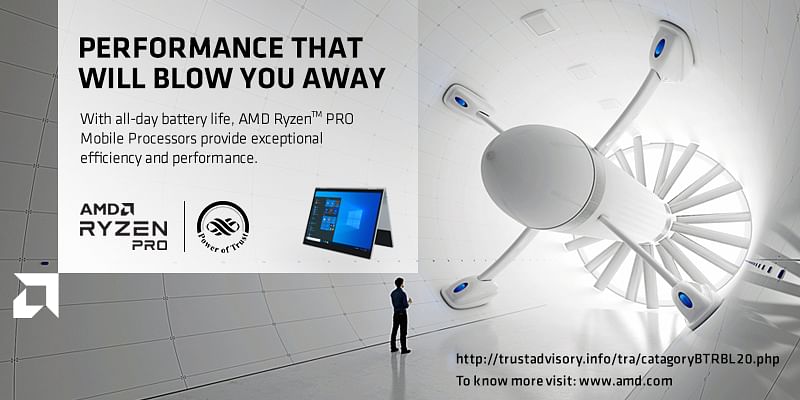Selecting new devices for employees is difficult, especially if the laptops you’re considering contain a processor from a different manufacturer than the ones already in your fleet. Being able to use the same deployment process across all devices—regardless of processor—makes things easier on your IT staff.
We used an automated task sequence in Microsoft Configuration Manager (formerly
SCCM) to deploy a Microsoft Windows 10 Pro image on four enterprise laptops:
• Lenovo® ThinkPad® T14 laptop with an AMD Ryzen™ 5 PRO 4650U processor
• Lenovo® ThinkPad® T14 laptop with an Intel® Core™ i5-10310U vPro® processor
• HP EliteBook 835 G7 Notebook PC with an AMD Ryzen™ 5 PRO 4650U processor
• HP EliteBook 830 G7 Notebook PC with an Intel® Core™ i5-10310U vPro processor
When we performed the same six steps on all the devices, each enterprise laptop required a similar amount of hands-on administrator time – between 1 minute and 38 seconds and 1 minute and 49 seconds. The difference in total time required, including system time, was less than two minutes across all devices. If you’re considering managing a fleet with both AMD and Intel processor-based PCs, deployment time or adaptations to existing Windows 10 Pro image deployment processes shouldn’t be a concern.
Keep doing what works
Some admins and organisations have steered away from laptops equipped with AMD processors because they assumed that managing a mixed-CPU Windows 10 environment would be more complex than managing a homogeneous one.
We first compared Windows 10 image deployment processes for equivalent systems equipped with the rival processors in 2018. Then, as now, we found that admins could deploy a Microsoft Windows 10 (or Windows 10 Pro) image to systems equipped with AMD processors without altering processes they developed for Intel-based systems. In fact, in 2018, we found “Windows 10 image deployment to AMD processor-powered laptops and desktops took similar time and the same number of steps as deployment to systems powered by Intel.”1 You can read the 2018 report here.
Have the same experience, regardless of CPU
If your organisation is one of the many that has shifted to a more remote workforce, no-touch PC management is likely a high priority. Streamlining OS deployment and driver installation can help give your IT teams more time and brainpower to tackle complex and challenging problems.
We created a Configuration Manager task sequence and used it to deploy a Windows 10 Pro image on all four enterprise laptops. This automated sequence included applying the OS, configuring network settings, adding drivers, and installing Slack and Microsoft 365 applications.
Deploying the OS
Having a single deployment process for all devices makes it easier for IT to ensure that employees receive their new devices as quickly as possible.
In our testing, it took slightly less time to deploy a Windows 10 Pro image to the AMD Ryzen 5 PRO 4650U processor-based Lenovo ThinkPad 14 laptop than to perform the same process on the Intel Core i5-10310U vPro processor-based Lenovo device. The AMD Ryzen 5 PRO 4650U processor-based HP EliteBook 835 G7 Notebook PC was also slightly faster to deploy than the Intel Core i5-10310U vPro processor-based HP system.
Deploying one laptop using Configuration Manager
Figure 1: Total time (mm:ss) to deploy one laptop using Configuration Manager. Admin time refers to the time it took us to start the installation process on the target PC, and system time refers to the time it took our task sequence to install the OS, install drivers and applications, and configure the system. Lower is better. Source: Principled Technologies.
Installing drivers
When IT prepares new devices for end-users, their standard procedure often includes loading drivers onto a custom image that installs the company-supported OS and deploys company-approved applications. We simulated this scenario in our testing.
On all four devices, we added driver packages to Configuration Manager before deploying the Windows 10 Pro image. This enabled the automated sequence to complete all OS updates and customisations on each laptop.
The process of adding drivers, requiring 11 steps, was the same on each of the four devices. Installing the drivers took a similar amount of time, with the AMD Ryzen 5 PRO 4650U processor-based devices taking from 1 to 4 seconds longer than their Intel Core i5-10310U vPro processor-based counterparts.
Figure 2: Admin time (mm:ss) to add drivers to the boot image and driver package. Lower is better.
Source: Principled Technologies.
Conclusion
In our testing, using Configuration Manager to install drivers and deploy a Windows 10 Pro image was fast and easy on all four enterprise laptops. The two AMD Ryzen 5 PRO 4650U processor-powered devices required identical steps and a similar amount of hands-on time to deploy as the two Intel Core i5-10310U vPro processor
powered devices. Our recent findings are consistent with our findings in 2018, which indicates that there’s no need to develop or alter existing Windows 10 Pro image deployment processes when introducing AMD or Intel processor-based PCs into your environment.
1. Principled Technologies, “Deploy a Microsoft Windows 10 image to AMD Processor-based
systems without altering existing processes,” accessed January 29, 2021, https://www.principledtechnologies.com/AMD/PRO_processors_image_deployment_competitive_0518.pdf
2. Microsoft, “Overview of Windows Autopilot,” accessed January 29, 2021, https://docs.microsoft.com/en-us/mem/autopilot/windows-autopilot.
Lenovo comparison testing details: http://facts.pt/r13DTvg
HP comparison testing details: http://facts.pt/dxnv42z










